Rosa Raisa

Rosa Raisa (30 May 1893 – 28 September 1963) was a Polish-born, Italian-trained, Russian-Jewish dramatic operatic soprano, who became a naturalized American.[1] She possessed a voice of remarkable power and was the creator of Puccini’s last opera Turandot at La Scala, Milan.
Life and Career
Early Life and Operatic Beginnings
She was born as Raitza Burchstein, daughter of Herschel and Frieda Leah (Krasnatawsky) Burchstein, in Białystok, in partitioned Poland (then Russian Empire) on 30 May 1893. Her mother died in 1899 and Herschel remarried, Chaya. Along with her cousins (Sasha Vigdorchik and his family) she fled Poland when she was 14 due to the Bialystok pogrom, emigrating to the Isle of Capri, Italy. There Raitza met Dario Ascarelli and his wife Ester], who recognized her talent and potential and sponsored her at the Naples Conservatory (San Pietro a Majella). Her teacher at the conservatory, the contralto Barbara Marchisio (1833–1919), had been one of the most prominent Italian singers of the mid-19th century.[2]
Marchisio brought Raisa in 1912 to Cleofonte Campanini, a leading operatic conductor and impresario. After the audition, he engaged the 20-year-old singer for the 1913 Parma Verdi Centenary: Oberto, Conte di San Bonafico and Un ballo in maschera, and also signed her for his Philadelphia-Chicago Opera. As she was under 21 years of age, her engagement was confirmed in a handshake.
Debuts in Europe and America
Debuts and successes followed rapidly for Raisa. Her North American debut was on 14 November, 1913 with Campanini’s Chicago-Philadelphia Opera Company in Baltimore as Mimí in La Bohème with Giovanni Martinelli of the Metropolitan Opera in his first season in North America. (Martinelli was to be her partner in 1937 in her last stage appearance of her career in Halévy’s La Juive in Chicago). Her first role in Philadelphia was Isabella of Aragon in the United States premiere of Alberto Franchetti’s Cristoforo Colombo, followed by her Chicago Aida debut (29 November, 1913) at the famous Auditorium Theater. Edward Moore, then critic of the Chicago Tribune, stated that hers was "a voice the like of whose power had never been heard on that stage."[3]
She added several roles to her stage repertoire with the Chicago-Philadelphia company: Santuzza in Cavalleria Rusticana (Dallas), Donna Anna in Don Giovanni (Philadelphia), and Klytemnestra in Vittorio Gnecchi's Cassandra (Philadelphia—Western Hemisphere premiere), and Elsa in Lohengrin in English (Seattle).

In the spring of 1914 she went to London where she debuted at Covent Garden in Aida with Enrico Caruso, participated as Helen of Troy in Arrigo Boito’s Mefistofele with Claudia Muzio, John McCormack and Adamo Didur, and substituted for Claire Dux as the Countess in Le nozze di Figaro. The London company went to Paris and she sang her only Nedda in Pagliacci and again sang Amelia in Verdi’s Un ballo in maschera. In November 1914 publisher Tito Riccordi, who had personally auditioned Raisa in his home, recommended her to the management of the Modena opera for a long run (Raisa recalled nineteen performances) of Riccardo Zandonai’s new opera, Francesca da Rimini, first performed in Turin only a few months earlier.

This led to an engagement at the Teatro Costanzi in Rome for more Francesca’s, Aida's and two novelties, Fedra, a prize-winning opera premiere by a young Romano Romani (later on Rosa Ponselle’s coach and lover) and Abdul by Brazilian Alberto Nepamuecno. Legendary Emma Carelli, an esteemed soprano in her own right, now the director of the Rome Opera introduced Raisa to her husband Walter Mocchi, the important impresario who organized the glamorous opera seasons in Buenos Aires. As South America was in the Southern Hemisphere, there was a long-standing tradition of the best Italian artists boarding ships after the end of the opera season in Italy and performing in the reverse seasons, the autumn and winter months in South America. The annals of operatic performances in South America read as the “greatest” Italian opera to be seen, the Teatro Colón in Buenos Aires a defining theater.
Mocchi took Raisa in May 1915 to South America for a long season, first in Buenos Aires and Rosario in Argentina, Montevideo in Uruguay and Sao Paulo, Rio di Janeiro and Porte Allegre in Brazil. In addition to her Francesca’s and Aida’s (again one with Caruso) she added L’Africana also starring Titta Ruffo and sang the Marschallin in the South American premiere of Der Rosenkavalier in Italian with Gilda dalla Rizza as Octavian and the then unknown Amelita Galli-Curci as Sophie. All these operas were under the leadership of Gino Marinuzzi, the great Italian conductor and composer who for many years championed Raisa.
La Scala and Puccini
Raisa made her La Scala debut as Francesca upon her return from South America. She performed many Francesca’s and Aida’s as well as Lida in Verdi’s rare early opera La battaglia di Legnano at the Scala. It was after her Francesca at La Scala that she encountered Giacomo Puccini, who visited her after the performance. He was so taken with her performance and potential, Raisa later told the press, that when she asked him which of his operas he thought best for her to tackle, Puccini said: “there is no opera I have written to which your voice is not suited; they are all the same for you.”[4] He told her he wanted her to create his next opera (still a work in progress, La rondine) Whether he was more entranced with her youth and beauty or her vocal powers is unknown, but his plan for this assumption of Magda was advanced enough that she was in January 1917 announced in the world press for the premiere of this light opera in Monte Carlo. Raisa did not go to Monte Carlo as she was in the United States and was fearful of the submarine warfare at that stage of the Great War. Interestingly at about the same time Puccini first encountered Raisa, Arturo Toscanini heard her and told his friends in the opera world that he considered Raisa a “female Tamagno,” more appropriate for the heroic Turandot she would create nine years later.
In 1916 she reprised her Francesca’s and Aida’s at the Rome Opera and returned to South America for another exhausting season, adding “Loreley,” Valentina in Gli Ugonotti (Les Huguenots) and Alice Ford in Verdi’s Falstaff. Falstaff was to play a large part in her career for it gave her an only chance to play the the non-title role in an opera with baritone Giacomo Rimini, at that time her lover and after 1920 her husband. In August 1916 Campanini elaborated to the Chicago Tribune his plans for the upcoming 1916-17 season of the Chicago Opera Association (no longer the Chicago-Philadelphia Opera Company), and clearly building up the return of Raisa to Chicago, quoting Caruso, “he considers Rosa Raisa the greatest dramatic soprano in the world.”[5] The only problem with Campanini’s prediction was that Amelita Galli-Curci was to take Chicago, and the world by storm and she ultimately became the superstar attraction of the company.
Chicago Years
After her return to Chicago in 1916, Raisa along with Mary Garden, Edith Mason, Claudia Muzio and Amelita Galli-Curci were the lead sopranos around which the repertoire of the company revolved. Essentially Raisa was the company’s dramatic soprano, Mary Garden the French-repertory soprano, Galli-Curci the light coloratura, Edith Mason a lyric, and Claudia Muzio a spinto soprano. Of all these, Claudia Muzio was the only one to share some roles with Raisa (Leonora in Il trovatore, Desdemona in Otello, Aida, Santuzza, and Tosca).

Raisa was the company’s only Maliella in Wolf-Ferrari's I gioielli della Madonna (Jewels of the Madonna), Gioconda, Amelia in Un ballo in maschera (always billed as Masked Ball in Chicago), Rachel in La Juive (always announced as The Jewess in Chicago), and of course the ultimate touchstone opera for dramatic sopranos, Norma in Bellini’s opera. This is significant as Claudia Muzio had performed Norma with some success in Italy and South America, but staked no claim to the role over Raisa in Chicago.
Raisa over the next 16 seasons (1916-17 to 1931-32) sang almost five hundred times in Chicago and on its transnational tours. She also sang two long seasons in Mexico (1917 and 1919) returned to South America for three more seasons (1918, 1921, and 1929). She added Norma to her repertoire in Buenos Aires, singing it 22 times alone in that important city in three seasons. Leonora in Il trovatore, Tosca, Margherita in Mefistofele, and Lo Schiavo were added to her role list in Latin America. In Chicago she added Maddalena in Andrea Chénier, Zina in de Gounzberg’s Le Vieil Aigle, Isabeau in the North American premiere of Mascagni’s opera, Maliella in 'I gioielli della Madonna, La Gioconda, Basiliola in Montemezzi’s La Nave, Puccini's Suor Angelica, Elisabeth in Tannhäuser, Minnie in La Fanciulla del West, Leonora in La forza del destino, Cio-Cio-San in Madama Butterfly (at the Ravinia Festival outside Chicago, also Giordano’s Fedora at Ravinia), Toinette in Frank Harling’s jazz opera A Light From Saint Agnes, Rosalinde in an English-language Die Fledermaus, and Concita in Zandonai’s opera of the same name.
World Premieres: The First Turandot and Asteria
Raisa also, of course, famously added to her repertoite the role of Asteria in Boito’s posthumous opera, Nerone (1924), and the title role in Turandot (1926) at Toscanini’s La Scala, both world premieres in the most lavish Scala productions of that storied era. In Raisa’s version of the Nerone rehearsals, Puccini managed to enter into the auditorium at an early rehearsal and Toscanini had a “fit” when he realized Puccini was in the house, as it was his firm policy that no one was to be present at the early rehearsals prior to the final dress rehearsal at which the Milanese opera establishment would be invited, no exceptions, not even for Puccini. It fell to Raisa to escort Puccini to the stage door; it was then that Puccini, who had heard some of the early scenes of the Boito opera which featured some stentorian high notes, told Raisa that he was writing Turandot, "It is a role I can just see you and hear you” and he wanted her to create it, telling her that only the final scene still had to be composed.[6] In an interview with the Chicago Tribune the day after word came that Puccini died in Brussels, Raisa told the newspaper that she had playfully told Puccini that he “better be sure to put in plenty of high C’s.”
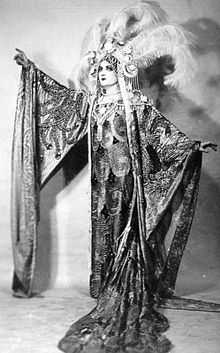
La Scala, Italy (photo by Castagneri)
On October 7, 1924, less than two months before Puccini died, Angelo Scandiani, administrative director of La Scala, wired Herbert Johnson of the Chicago Opera that Puccini and Toscanini had cast three Chicago Opera artists, Rosa Raisa, Edith Mason, and Giaccomo Rimini, for the lead roles in the upcoming Turandot. At that time it was thought that the premiere would take place in April 1925, but Puccini’s death at the end of November 1924 postponed these plans; Franco Alfano was selected to compose the final scene from Puccini’s sketches.
The premiere was on 25 April 1926 with Raisa as Turandot, Miguel Fleta, the acclaimed Spanish tenor as Calaf, and Maria Zamboni, a Scala lyric soprano, cast as Liu, replacing Edith Mason who was pregnant. It is at this performance that Toscanini stopped the performance at the place Puccini stopped composing, addressing the audience with essentially these words “here is where the Maestro died.”[7] John Gutman of the Metropolitan Opera in a 1962 interview with Raisa asked her if the artists knew that Toscanini would make this gesture. Raisa said that there were rumblings backstage that something like this might happen, but the artists were never told this officially; therefore, they were somewhat, but not totally, surprised. There is anecdotal information that Puccini on his deathbed asked Toscanini to make such a gesture at the premiere, but this is not possible to confirm.
New Chicago Opera House; First Broadcasts
On 4 November 1929, Raisa was awarded the honor of opening the new Chicago Civic Opera House in a performance of Aida (broadcast throughout the USA) with a stellar cast personally selected by Civic Opera president Samuel Insull, the Chicago industrialist who later ran foul of the law. Raisa and Rimini invested their considerable earnings in Insull securities (actually a ponzi scheme) and eventually lost their fortune, on paper estimated in the range of a million dollars.[8]
Most people in the United States believe that high quality opera broadcasts started with the Metropolitan Opera in 1931. The Chicago Opera was broadcasting nationally since 1927, every week for one hour; Mary Garden, Claudia Muzio, Frida Leider, Raisa, Tito Schipa, Eva Turner, Alexander Kipnis and Vanni-Marcoux are some of the headliners who were heard on the radio across America. It is doubtful that any of these transmissions have been preserved.
1933: Last Performances on Stage
1933 is the last year that Raisa performed a reasonably full schedule. Since January 1931 when she left the stage to prepare for the arrival of her daughter, having had six unsuccessful pregnancies, many things happened: the demise of the Chicago Opera, the world-wide deteriorating economic situation and a general contraction of operatic activity in the United States. But Raisa sang a run of Tosca in Genoa, created Manuela in Zandonai’s one-act opera “Una Partita” at La Scala, sang Alice Ford in Falstaff with Rimini at the first Florence May Festival (Maggio Musicale Fiorentino), Tosca in the presence of Queen Mary at Covent Garden, recorded four verismo arias for Voce del Padrone in Milan, *and* sang in five performances of Gli Ugonotti at the Arena in Verona with Giacomo Lauri-Volpi and a stellar cast. She can be seen, but not heard, in an edited version of the Act IV Love Duet with Lauri-Volpi who is thrilling as Raoul. [9]
Concerts
Rosa Raisa married the Italian baritone Giacomo Rimini (1888–1952) in 1920; the couple had first met five years earlier and were inseparable lovers. Rimini was descended from Sephardic Jews on his father’s side and his mother was Hungarian-Italian. Rimini was raised as a Catholic. Their careers merged and after retirement in 1938 they opened a voice/opera school together in Chicago, first at the historic Congress Hotel, across from the Auditorium Theater, and during World War II they moved to North Michigan Avenue. Their daughter Rosa Giulietta Frieda Rimini was born 7 July 1931.
They sang hundreds of concerts together, especially in the United States, many of them sponsored by Jewish groups as Raisa had become a beloved ethnic icon. Her concerts were almost always with Rimini, she singing two-thirds of the concert, he one-third. They closed the first half, and the end, with duets. The most frequent duets they sang were “La ci darem” from “Don Giovanni” where they could be outwardly playful and sexy. The Act IV duet from “Il Trovatore” was often given at the end of the printed concert. It is fascinating that they often sang after the first half of a concert a duet from Verdi’s “Luisa Miller,” giving Raisa an opportunity to do some flashy coloratura and ending on a high C. She often closed her recitals with the Yiddish song "Eili, Eili".[10]
“Eili Eili” is a Yiddish song starting with the Hebrew words Eili, Eili, (“God, why have you forsaken us?”) and ending with the Jewish credo, “Sh’mah Yisroel” (“Hear O Israel, the Lord our God, the Lord is One.”) This song exists in several arrangements. Raisa had the popular music composer Joseph Bonomie arrange the song for her voice. Her 1918 recording is remarkable for it shows the cello-like coloring of the lower voice, the liquid middle register, as well as the ease of her upper. And she sings the song with great feeling, appropriately sobbing on key words. It was reported that she often sang this song with her eyes closed. (It can be heard on Youtube, accessed on May 2, 2015.)
Death
Raisa suffered from cancer, having undergone a double mastectomy in the 1940s. She died on September 28, 1963 and her granddaughter, Suzanne Homme, told Raisa's biographer Charles Mintzer that her death certificate listed “bone cancer” as the immediate cause of death. She was buried in Holy Cross Cemetery in Culver City (Los Angeles), California.
Recordings
Raisa's relatively few recordings (from 1917-1933 for four different record companies, Pathe, Vocalion, Brunswick, and Italian HMV) reveal a beautiful timbre and a florid technique rare in singers of her type. Her famous vocal power, almost always mentioned in reviews, can only be detected in a few of the recordings. An anthology of these recordings was issued in 1998 on CD by Marston Records (53001-2). The Marston issue also contains an audio interview with Raisa, while its liner notes feature valuable biographical information about her and an evaluation of her voice.
In almost all the reviews of her live performances there is usually amazed reverence of her phenomenal vocal power. Only on the electric Italian HMVs can some of this power be detected. Alan Kelly, the HMV expert and historian told Larry Lustig of The Record Collector magazine that the logs of that May 1933 recording session had notes: “bad" microphone technique and “blasting.” She had to be placed in the middle of the orchestra to achieve some reasonable balance.[11] The HMVs do not show Raisa’s voice at its freshest, but the voice is extremely golden and beautiful, with magisterial delivery, and a sense of unusual power. Lauri-Volpi in his seminal book on singers of his experience and knowledge, Voci Parallele, states that by 1933 Raisa’s voice was but an x-ray of how he remembered her earlier in her career.[12]
Gallery
Operatic Roles
-

Maliella in I gioielli della Madonna, Chicago, 1917.
-
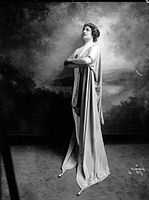
Norma, 1918. Mishkin photo taken in New York City before her first Norma in Buenos Aires in 1918.
-
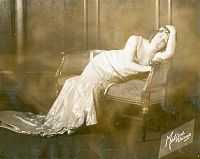
Tosca, Chicago Opera, 1919.
(Matzene photo) -
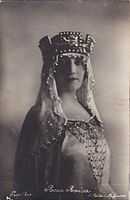
Elisabeth in Tannhäuser, 1921.
(Hartsook photo, Los Angeles) -

Rachel in La Juive, Chicago Opera, 1922. (Fernand de Gueldre photo)
-
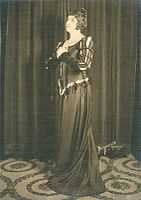
Gioconda, Chicago Opera, 1924.
(Daguerre Studio)
Family and friends
-

Private photo of Raisa's father Herschel Burchstein relaxing in Lakewood, New Jersey, 1922.
-

Raisa's husband Giacomo Rimini, an Italian baritone, Mexico City, 1917.
-

Raisa annotated this photo of her teacher Barbara Marchisio and her sister Carlotta, planning to use in her autobiography. "Barbara Marchisio my vocal teacher in Adalgisa Norma. Carlotta Marchisio as Norma. Both sisters great singers with glorious careers.” (1860s)
-
.jpg)
Good friend Rosa Ponselle, an American soprano, inscribed: “To the great artist and my dear friend— from the other Rosa who loves you dearly. Rosa" (ca. 1938).
Notes and References
- ↑ General books and reference works identify Raisa as either Polish-Jewish or Russian-Jewish. For her views, see the interviews for The Jewish Forum (vol. 5, January 1922, pg. 234) and Harriette Brower, Vocal Mastery: Talks with Master Singers and Teachers (Frederick A. Stokes Co.: New York 1920, pg. 94). This and other aspects of her life and career are presented in greater details in Charles Mintzer, Rosa Raisa, a Biography of a Diva with Selections from Her Memoirs (Northeastern University Press: Boston 2001).
- ↑ See Marchisio's entry in The Concise Oxford Dictionary of Opera, edited by Harold Rosenthal and John Warrack, Oxford University Press, second edition, 1980.
- ↑ Edward R. Moore, Forty Years of Opera in Chicago (Horace Liveright: New York 1930, pg. 127).
- ↑ See “The Youngest Prima Donna" in The Musical Leader magazine (October 1916) and “The Brilliant Career of Rosa Raisa” in the Chicago music magazine Music News (October 1916)
- ↑ Chicago Tribune (August 22, 1916).
- ↑ Raisa’s interview with John Gutman on Metropolitan Opera Turandot broadcast, February 1962.
- ↑ There are many versions of this famous statement.
- ↑ Mintzer, Rosa Raisa, pg. 160-164.
- ↑ This excerpt is available on YouTube; it was featured in a German-made documentary about Lauri-Volpi.
- ↑ Mintzer, Rosa Raisa, pg. 286.
- ↑ Mintzer, Rosa Raisa, pg. 308.
- ↑ Giacomo Lauri-Volpi, Voci parallele (Reprinted by Bongiovanni, Bologna, 1977).
Further Reading
- Charles Mintzer, Rosa Raisa, a Biography of a Diva with Selections from Her Memoirs. Northeastern University Press: Boston, 2001.
- Michael Scott, The Record of Singing. Vol 2: 1914-1925. Duckworth: London, 1979, pg. 71-73.
External links
- Biographical sketch and photos at cantabile-subito.de
- Liner notes for the complete recordings issued on Marston Records
|